University Housing is in the process of testing energy-saving applications, including occupancy sensors, automated heating and air conditioning control and LED lighting in dorms, Barry Olson, associate director of housing’s and facilities, said.
“We are going to test LED lights in lounges in a few buildings as well as one of the lobbies of Wolf Village,” he said. “We’re not necessarily testing for energy efficiency because we know [LED lights] save energy. We’re testing in terms of making sure we can install the lights and produce the kind of light we want in those environments.”
The company that created the lights installed in Bragaw is likely to come out with a new 24-by-24-inch ceiling-grid-mounted LED light fixture in November, according to Olson.
“This design makes more sense for us,” he said. “With a suspended ceiling grid, it is easy to swap out an old fixture for the 24-by-24 LED fixture.”
Housing is considering using occupancy sensors in public spaces as another way to save energy, according to Olson. These sensors would be used to prevent rooms from being lit when they are unoccupied.
“We often find empty rooms with lights on full blast,” Olson said. “These sensors kind of think for us.”
According to Olson, Housing also is looking to automate heating and cooling processes so rooms are not heated or cooled when they are unoccupied.
“We have incorporated that automation in Tucker Hall,” he said. “We have installed automated controls across campus, not just in the residence halls.”
LED lights installed in Bragaw residence hall over the summer are an example of where energy-saving efforts have begun to pay off, according to Brandon Vann, an energy data analyst with Energy Management.
Energy consumption in Bragaw residence hall is down after LED lights were installed over the summer, Vann said.
The number of kilowatt-hours used from June to September of this year was 56 percent of the number of kilowatt hours consumed during roughly the same period in 2007. About 97,922 fewer kilowatt hours were used during the four month period compared to last year.
Part of the goal of these energy-saving efforts is to encourage students to do the right thing, according to Olson.
“We want to encourage the right behavior and make it easier for a student to conserve,” he said. “We want to help them do the little things.”
Kerry Lynch, a sophomore in communication, said efforts to conserve energy are worth it.
“Our campus spends a lot of money that we could save and help the environment at the same time,” she said. “We can be greener in that respect.”
Lynch said she thinks efforts to conserve energy will be successful if they are implemented campus-wide.








